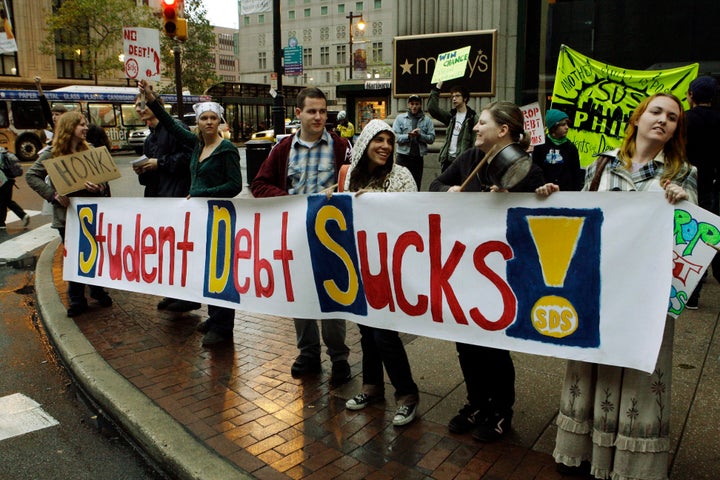
WASHINGTON -- Record borrowing by college students who are graduating without jobs could lead to major problems in the nation's economy, according to a recent report by Moody's Analytics.
"The long-run outlook for student lending and borrowers remains worrisome," concluded the report, which came out in July.
"Unlike other segments of the consumer credit economy, student loans have not demonstrated much improvement in performance despite some improvement in the broader economy. ... [T]here is increasing concern that many students may be getting their loans for the wrong reasons, or that borrowers -- and lenders -- have unrealistic expectations of borrowers' future earnings."

The Moody's report points to the fact that student loan volume growth, unlike other lending, has accelerated during the recession. This is due in part to people seeking more education and retraining as well as some students opting to remain in college longer to avoid poor job prospects.
The report indicated that in addition to college enrollment tripling over the past four decades, "demand [for student loans] is driven by the cost of education, which has grown at an extraordinary rate over the past three decades." Based on Consumer Price Index data, the cost of tuition and fees has more than doubled since 2000, and has outpaced inflation across all goods, health care, housing and energy.
Student lending has also increased due to state governments making cuts to their public education institutions, causing colleges to raise tuition. Further, college endowments have recovered slowly throughout the economic downtown, forcing schools to increase tuition and limiting the amount of in-house money for scholarship use.
The student loan debt load now outpaces credit card debt, and according to Mark Kantrowitz, who publishes the financial aid websites Fastweb.com and Finaid.org, the average 2011 college graduate carries $27,200 in student debt.
"Fears of a bubble in educational spending are not without merit," the Moody's report said.
Using consumer credit data from Equifax, Moody's noted the original borrowing amounts taken out by students have risen significantly over the past two years.
For-profit schools, which have much lower graduation rates than traditional colleges, have also grown rapidly.
Youth unemployment among those under the age of 24 has been much higher than the rest of the workforce -- creating an even more pessimistic outlook for student loan repayment. In the U.S., it was over 15 percent for the first quarter of 2011, and is similarly problematic around the world.
However, the report notes there could be negative implications if people take out fewer loans, when that is their only means to attend college. In the short term, if fewer people pursue higher education and avoid student debt altogether, it would cause a drag on consumption. In the long term, a less educated workforce would put the U.S. at a disadvantage.
With the changes coming to student loans by the recent debt ceiling agreement, some college students will inevitably see even more debt by the time they graduate.
In the Budget Control Act of 2011, the agreement to raise the debt ceiling, subsidized federal student loans were put on the chopping block. Beginning next July, graduate and professional students -- those who already have bachelor's degrees and seek masters or doctorates -- would be charged interest while in school. According to Finaid.org, this would potentially increase students' total debt by graduation by 16 percent.
The cuts to federal student loans were redirected toward shoring up Pell Grants. After the details were announced, Pauline Abernathy, vice president of the Institute for College Access & Success, expressed concern for the more than nine million students who utilize Pell grants.
"Even with a Pell Grant, recipients are more than twice as likely as other students to have to take out student loans, and they graduate with significantly more debt than other students," Abernathy said in a statement last week.
According to the Associated Press, the promise of further cuts from the "super committee" -- formed as a result of the debt ceiling agreement -- raises concerns of reductions in tax breaks to offset the cost of college and the low interest rates of federal student loans.
CORRECTION: An earlier version of this article inaccurately conveyed the conclusions of the Moody's report. The report did not suggest that the student loan market might lead to the next financial crisis. It called the outlook "worrisome" and said "fears of a bubble in education spending are not without merit." The word "Analytics" was also added to the headline of the article for clarification.
